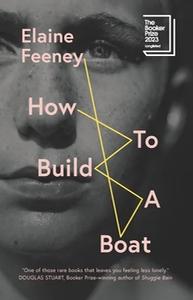
 Elaine Feeney's second novel, How to Build a Boat, is a study in contrasts. Simultaneously quiet and riotous and equal parts light and darkness, the Booker Prize longlisted novel focuses on Jamie, starting his first year at an all-boys secondary school in West Ireland. Jamie displays many traits of neurodiversity, such as hyperfixation, pattern recognition, and sensory dysregulation, but Feeney (As You Were) applies no diagnostic label; instead, she has Jamie speak for himself, and his voice--the driving force behind this novel--is spot on. Jamie loves maths, the lectures of Field Medal-winner Maryam Mirzakhani, and the color red. He speaks plainly about his mother Noelle's death at his birth, though the fact of it doesn't change his desire to build a perpetual motion machine, one that relies on no energy inputs, one that might connect him to Noelle. Jamie "knew something was missing, a vacuum to where a mother should fit, and he had a fixed determination to fill it."
Elaine Feeney's second novel, How to Build a Boat, is a study in contrasts. Simultaneously quiet and riotous and equal parts light and darkness, the Booker Prize longlisted novel focuses on Jamie, starting his first year at an all-boys secondary school in West Ireland. Jamie displays many traits of neurodiversity, such as hyperfixation, pattern recognition, and sensory dysregulation, but Feeney (As You Were) applies no diagnostic label; instead, she has Jamie speak for himself, and his voice--the driving force behind this novel--is spot on. Jamie loves maths, the lectures of Field Medal-winner Maryam Mirzakhani, and the color red. He speaks plainly about his mother Noelle's death at his birth, though the fact of it doesn't change his desire to build a perpetual motion machine, one that relies on no energy inputs, one that might connect him to Noelle. Jamie "knew something was missing, a vacuum to where a mother should fit, and he had a fixed determination to fill it."
On the other side of the narrative are Tess Mahon and Tadhg Foley, both teachers at the school Jamie is set to attend. Tess and her husband, Paul, are facing the final round of in vitro fertilization, and Tess has just learned her Additional Needs students have all been transferred out of Christ's College. Tadhg is the new woodwork teacher, just arrived from the islands, and the source of the project that gives this book its title. Tess and Tadhg offer Jamie extra support, seeing him for the brilliant but needful young person that he is. Read one way, this is a story about a team of loving adults surrounding a student in need; read another way, however, How to Build a Boat takes on greater dimension, and readers will share in the glow that comes when Jamie and his boat project become the source of an unexpected and undeniably beautiful community.
Along the way, Feeney layers in cutting commentary on gender politics, and the dangers that can lurk in conservative single-sex schools. Employing Jamie's unvarnished but occasionally oblivious perspective, Feeney balances direct critique with more subtle implications or questions raised. Feeney has crafted a novel--from setting to voice--that manages to feel completely fresh yet still timeless, full of human frailties and failings, yet covered with goodwill. --Sara Beth West, freelance reviewer and librarian
Shelf Talker: Elaine Feeney's second novel is a brilliant coming-of-age story, focusing on neurodiverse Jamie and the teachers who support him as he navigates his first year at a religious school in West Ireland.

